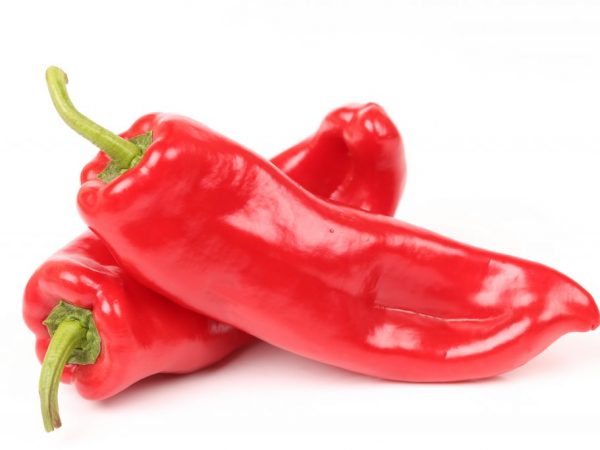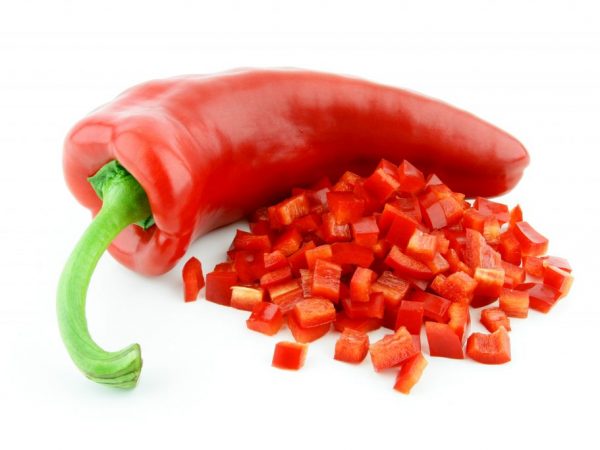Characteristics of Pepper's Ear
Bell's ear sweet pepper is gaining more and more popularity among gardeners. The reason for this is the pleasant taste of the vegetable and the benefits for the body. Let's consider the description of the variety in more detail.

Pepper cow's ear
Characteristics of the variety
The cow's ear was bred in Russia at the beginning of the 21st century. Just a few years later, he went through all the stages of research and was entered in the State Register of the Russian Federation.
Bell pepper grows better in warm climates; in colder regions of the country, it is grown in greenhouses.
The growing season of the plant is 90 days. After 3 months, technical ripeness is observed: the fruit gains the necessary mass and shape, but does not stain. Full maturation occurs 120 days after planting the seedlings in a permanent place.
The yield characteristics are high: from 1 sq. m collect about 5 kg of fruit.
Description of the bush
According to the description, the height of the bush is no more than 70 cm, the foliage is average, but rather spreading.
The leaves are rich green, with an elongated end, have small veins. The root system is powerful.
Features of the fetus
The pepper resembles an elongated cone in shape. The following characteristics of the appearance of the fetus are also distinguished:
- length - about 18 cm;
- weight - about 250 g;
- red fruit with a glossy finish;
- wall thickness - 0.6 cm.
The taste of the fruit is sweet, without bitterness.
Pepper variety Volovye ear manifests itself fresh or salads, suitable for preservation or pickles.
Growing rules
Cultivation is carried out only by the seedling method, therefore, it is necessary to prepare seedlings from the beginning of spring.
To sow the seeds, use the soil from the garden. It is not necessary to add other impurities to it. It is better to pour the soil into the seed containers, into which the seedlings will be planted in a permanent growing area. This trick is needed to reduce the stress level for the plant after planting in a permanent place.
Seed preparation
Seeds must be thoroughly prepared before planting. First of all, you need to select high-quality seeds that can sprout. For this, all the prepared planting material is placed in a container with water. All seeds that have floated to the surface are removed, because they do not have a special sprout that will allow them to emerge.
After that, the selected seeds are soaked in a solution of manganese or aloe juice. This is necessary to disinfect the planting material and remove all harmful bacteria. This allows you to speed up the germination process and reduce the number of possible diseases to a minimum. After that, rinse the seeds and dry them in a warm place (you can use a battery).
Planting seeds in a container
Planting material is planted in containers with soil to a depth of 2 cm. All containers are covered with plastic wrap. It is important to stick to a temperature of 25 ° C. This is necessary for the correct development of the root system and the speed of germination.
As soon as the first shoots have appeared, the film is removed.The containers are placed in a well-ventilated area so that the seedlings get used to the ambient temperature.
Landing in the ground

Delicious pepper
After the appearance of the first pair of leaves, the seedlings are transplanted to a permanent growing site. It is better to use areas where pumpkins, cabbage or legumes were previously grown. It is not recommended to use plots from under tomatoes: such land has become depleted in useful microelements. The distance between the rows should be about 70 cm, and between the holes - 50 cm.
Care requirements
Caring for the Ox ear is the same as for other varieties of pepper. First of all, you need to take care of light and warmth. When growing sweet peppers in a greenhouse, ventilate it daily. Every day, the doors or windows in the greenhouse are opened for several hours so that the plant can saturate with oxygen. This is necessary for the correct formation of inflorescences. If you do not follow this rule, the ovaries will crumble, the yield will significantly decrease.
Watering
An important point is watering. It is carried out with warm water, otherwise the plant will not be able to assimilate it. The number of waterings per week directly depends on climatic conditions: the higher the ambient temperature, the more often you need to water the plant. The optimal frequency of watering is once every 3 days. One plant should have about 1.5 liters of water.
Loosening
It is imperative to loosen the soil and weed the beds. The stage of mulching the beds can be skipped, but the mulch does not allow the soil to become crusty, and the air penetrates better into the soil.
Top dressing
Top dressing of sweet bell pepper is carried out by the Volovye ear not only with organic, but also with mineral substances. Ideal development and yield rates are observed when feeding includes bird droppings, humus and superphosphate.
Diseases and parasites
The variety has a high immunity to viral diseases, it is resistant even to such a disease as tobacco mosaic. The species' only problem is the effects of parasites. Most often it is affected by Colorado beetles or aphids.
You can get rid of these pests with the help of chemical insecticides. From the Colorado potato beetle, drugs called "Regent" or "Confidor" will help. Aphids are destroyed by using Tabbu. Also, a solution of copper-containing preparations "Oxyhom" or "Abiga-Peak" will help from aphids.
Conclusion
If the gardener follows the rules for the care and cultivation, the fruiting of sweet bell peppers will last until the beginning of autumn. The cow's ear will be a wonderful decoration for the garden area and will bear a large number of excellent quality fruits.


